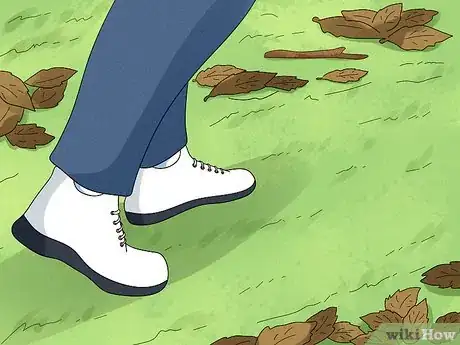This article was co-authored by wikiHow Staff. Our trained team of editors and researchers validate articles for accuracy and comprehensiveness. wikiHow's Content Management Team carefully monitors the work from our editorial staff to ensure that each article is backed by trusted research and meets our high quality standards.
This article has been viewed 75,835 times.
Learn more...
Walking silently through a forest floor covered with dried, brittle leaves takes patience and care. If your interest is sport hunting, you'll want to get as close as you can to your quarry because, the second it hears you, the animal will bolt. If you want to enjoy nature with causing as little damage to the environment as possible, there are techniques to employ. Learning to walk quietly will allow you to get close to the beautiful animals you want to observe, maybe even close enough for a memorable photograph.
Steps
Walking Quietly in a Forest
-
1Look where you're going. Watch the ground ahead of you carefully. Try to avoid stepping on obvious sound “landmines” like twigs or fallen bark.[1]
-
2Tread on live grass or bare dirt. Avoid dry grass and foliage which will crunch underfoot and make noise. Choose the clearest path to walk on – smooth, bare dirt is best. Mossy rocks also muffle the sound of your footsteps.Advertisement
-
3Walk slowly. Any time you are trying to be quiet, you should slow your pace and think about each step. Take three or four careful steps, then pause and regroup before continuing. If you rush through your steps, you will be far more likely to inadvertently make noise.[2]
-
4Map out your steps in advance. Instead of spending your entire time in the forest seeing nothing but your feet, try looking ahead and planning where you want to take your next few steps. This way you can keep your head up, and see more of your surroundings.[3]
-
5Walk heel-to-toe and bend at the knees. This method is sometimes called “fox walking.” Place the heel of your foot on the path ahead, then gently roll your foot down until the sole touches the ground. Avoid walking “flat-footed,” touching all surfaces of your foot to the ground at the same time – this will produce a much louder sound.
- Soft-soled shoes or light boots will make the least amount of noise in the forest.
- Place your foot down on the outer edge first, then roll the rest of your sole down until it touches the ground.
- Slowly shift your weight onto your foot, listening for any crackling or crunching noises. If you hear anything, stop immediately and move your foot to a new position.
- Crouch low and bend your knees, then walk slowly and carefully with your body balanced low over your center of gravity.
- Walk slowly. Slow your pace and think about each step. Take three or four careful steps, then pause and regroup before continuing.
-
6Try walking sideways if you need to move quickly. Stand with your destination directly to the left of you. Take your right foot and swing it across the front of your left leg and quietly put it down. Then take your left leg and swing it to the left behind your right leg. You may be able to move quietly and quickly in this fashion.[4]
-
7Run on the balls of your feet. If you need to run in the forest, try to touch only the balls of your feet to the ground. This requires more strength and better balance than normal running, and can be quite tiring if practiced for long periods.[5]
-
8Adjust for visual-aural delay. When walking with a group, the quietest method is for everyone to walk at the same pace. If you are walking with a friend who is a fair distance ahead, you may need to adjust your timing. Because sound travels more slowly than light, you may see their foot touch down ever so slightly before it makes a sound.[6]
- Pay attention to the length of time that elapses, then use that same amount of time to adjust your own steps – put your own foot down a split second before theirs will touch the ground.
- By the time the sound reaches them, it will match the sound their own foot has made.
- Boots or shoes with light, flexible soles make the least amount of noise in the forest.
Employing Traditional Native American Hunting Methods
-
1Try the cat walk. This method is used to stalk animals, allowing the hunter to get very close to his prey without being heard. It is usually only done for brief periods of time, because you will need to move very slowly.[7]
- When lifting your foot, point your toes at the ground. You will be less likely to snag your foot on foliage as you raise it.
- When putting your foot on the ground, connect the outer edge first, then roll the rest of the foot down until the sole touches the ground.
-
2Match your partners' pace. If you are walking with a partner or a group, everyone should match pace. When they put their left foot down, put your left foot down, and the same with your right. This way, the sound of your footsteps won't stand out over theirs.[8]
-
3Wear soft-soled shoes. Native Americans wore soft-soled moccasins while hunting because it helped muffle walking noises when hunting. Walking barefoot, or in a shoe that allows you to flex your foot, will allow you to feel the surface of the ground more accurately and avoid potential pitfalls like snapping twigs.[9] [10]
- If you must wear boots, wear the lightest and softest ones possible.
- Walking barefoot is the most quiet choice, but is usually too painful over rough terrain for most people.
- Kevlar toe socks are the rugged, outdoor version of the flexible running sock and is very similar to going barefoot.
Quieting the Rest of Your Body
-
1Breathe quietly. Breathe at a steady pace, inhaling and exhaling through the mouth. Forcing air through your nostrils creates more noise than breathing through your mouth.
-
2Suppress your sneezes. If you are trying to walk quietly in a forest, the last thing you want to do is sneeze loudly and give your position away. If you feel an urge to sneeze coming on, there are a few things you can try.[11]
- Try pressing down hard on your upper lip, just under your nose. Hold your finger there until the urge to sneeze passes.
- Hydrate your nose with saline nasal spray before you take your walk – this will prevent sneezes related to dry nasal passages.
- Avoid staring directly at sunlight, and wear sunglasses in bright daylight. Sudden exposure to sunlight can trigger a sneeze.
-
3Avoid noisy clothing. Check your clothing before you leave the house, to be sure you aren't wearing anything that makes noise. Avoid pants that rustle when you walk, jackets with dangling metal zipper pulls, and backpacks with jangling metal clips or D-rings.
-
4Mask coughing or rustling with background noises. If you need to cough or rifle through your backpack, try to time this to coincide with other noises around you. A rushing waterfall, an airplane overhead, or a car passing on a road nearby will camouflage small sounds.[12]
- If you feel a coughing bout coming on, try to hold it until you can mask it with a louder sound – maybe the person you're following will toss their pack to the ground to rest, or you hear a group of riders on horseback approaching down the trail.
Community Q&A
-
QuestionCan I use these methods for walking in daily life?
 Lily IrelandCommunity AnswerYes, all of these methods can be used outside of the forest. However, doing these methods in the forest makes you sound quieter.
Lily IrelandCommunity AnswerYes, all of these methods can be used outside of the forest. However, doing these methods in the forest makes you sound quieter.
Warnings
- When walking in remote area, plan a route, and let someone know where you will be, and when you will be back.⧼thumbs_response⧽
- If you are in an area with bears or other dangerous wildlife, make enough noise to give wildlife time to move away from your path. If you are too quiet you may startle a bear, which can create an extremely dangerous situation.⧼thumbs_response⧽
References
- ↑ https://delamagente.wordpress.com/2009/11/12/16-tips-in-the-science-of-walking-silently/
- ↑ http://www.fieldandstream.com/articles/hunting/2013/11/how-still-hunt-and-stalk-deer
- ↑ https://delamagente.wordpress.com/2009/11/12/16-tips-in-the-science-of-walking-silently/
- ↑ https://delamagente.wordpress.com/2009/11/12/16-tips-in-the-science-of-walking-silently/
- ↑ https://delamagente.wordpress.com/2009/11/12/16-tips-in-the-science-of-walking-silently/
- ↑ https://delamagente.wordpress.com/2009/11/12/16-tips-in-the-science-of-walking-silently/
- ↑ https://delamagente.wordpress.com/2009/11/12/16-tips-in-the-science-of-walking-silently/
- ↑ https://delamagente.wordpress.com/2009/11/12/16-tips-in-the-science-of-walking-silently/
- ↑ http://www.offthegridnews.com/extreme-survival/native-american-survival-skills/











































































